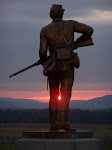As many of you may know, I am always scouring the news for articles on Gettysburg. No event in all of history is recorded in news articles so long after the fact as often as the Battle of Gettysburg is. The whole thing is an interesting phenomenon. The event symbolizes so many historical, cultural, political, and education traits of our society to this very day. Today in my findings, I found an interesting write-up on Col. Norman Hall of the 7th Michigan Infantry from the Monroe News. I thought I would share it with you.
Monroe County [Michigan] may not know Col. Norman Hall, but if local museum officials have their way, they will over the next couple of years.Col. Hall was a Monroe County native who was the only Michigan resident present at the bombing of Fort Sumter, which began the Civil War. And during the famous Pickett's Charge on the third day of the Battle of Gettysburg, it was Col. Hall's third brigade, which included the 7th Michigan Infantry, that held the Union center, halting the charge and leading to the Union victory.Those Civil War historical details are part of what Dave Ingall of the Monroe County Historical Museum plans to discuss at Thursday's Civil War Roundtable at Ellis Reference & Information Center. The talk will begin at 7 p.m."Hall has a very unique story," Mr. Ingall said. "He just has been forgotten."Monroe County's history when comes to the Civil War is unique, as well, and Mr. Ingall and others are making sure that history isn't forgotten. The discussion and slide show, which is expected to last a little more than an hour, include statistics from the Civil War, a look at the regiments that trained here, individual soldiers who participated, medal of honor winners, local and national Civil War monuments related to Monroe soldiers and county natives who are buried here and in other cemeteries.Museum officials are pushing the Civil War period now and hoping it becomes more recognized in years to come. The sesquicentennial of the war will be from 2011-15. Plans are being discussed for a Civil War monument to be erected at Soldiers and Sailors Park in Monroe, and Mr. Ingall said Monroe's great Civil War history is worth celebrating."We have a huge military history, dating back to the Battle of the River Raisin," Mr. Ingall said. "The town has a great military history. We have always had large participation in wars. Even the Mexican War (1844-45), we had quite a few." Mr. Ingall said the Civil War particularly hit Monroe County hard. When Fort Sumter was fired upon, "there was a huge uproar," he said.More than 2,250 county men served in the war, about 10 percent of the county's population, and about 430 died. The numbers fluctuate from time to time as new information becomes available. Local military historian Dave Eby has assisted Mr. Ingall with the statistics.There are countless stories about Monroe County men who served in the Civil War, and Mr. Ingall will relate some of those stories during his discussion. County men fought in every Michigan regiment and some of them trained in Monroe. The slides he will show feature area natives and their gravestones, as well as monuments from across the country."Michigan has monuments and plaques at many Civil War battlefields where they served," he said. Gen. George Armstrong Custer will be part of the talk, as will others, like Col. Hall.Col. Hall grew up on a farm near Dixon and S. Custer Rds. and attended Papermill School, a one-room schoolhouse. He was nominated to West Point by Congressman David Noble and the order was signed by Jefferson Davis, who later would become president of the Confederacy. He was at West Point at the same time as Gen. Custer. There is evidence that the two knew each other because a letter exists in which Gen. Custer mentions Col. Hall by name.The two also were instrumental on the third day of Gettysburg, perhaps the most important battle of the Civil War. "We would like to put up a statue of Col. Hall," Mr. Ingall said. "He was a hero at Gettysburg."Gen. Custer's Michigan Calvary Brigaide defeated Jeb Stuart's troops on one side of the battlefield. Meanwhile, Col. Hall was leading his brigade on the other
side during the famous Pickett's Charge."The brigade, led by Norman Hall, were the one's who repulsed them," Mr. Ingall said. "His was the final brigade that stopped Pickett's Charge ... and closed the gap in the Union line that shut Pickett's Confederates completely down."I'm not saying they saved the Union," Mr. Ingall continued, "but they played a huge role. . … If either one failed, the Union Army could have lost. That's amazing that two men from Monroe were that highly influential in the outcome." Col. Hall's history may have been forgotten because at the beginning of the war he contracted a disease and died soon after the war at 30.He's buried at West Point, about 30 yards from Gen. Custer. He is depicted in the renovated Cylcorama at Gettysburg today, and one of his battle flags, the 7th Michigan Infantry, is on display at the Monroe County Historical Museum.








Very interesting article. I will be in Gettysburg for Memorial Day week, and see where you are starting your new job there. Perhaps we will run into you on the battlefield. Good luck with the new job and I look forward to reading more of your blog.
ReplyDeleteThanks Patty. I hope you enjoy your trip!
ReplyDelete